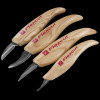Flex your woodcarving prowess!
I don't have the full set, only the Wharncliffe type detail knife. Excellent renowned ergonomic design. Nice and light for longer sessions. Very comfortable for your thumb, resting naturally on the wooden handle rather than on the back of a thin pocket knife blade, even more comfortable than a knife with a thicker spine, such as a Mora. Your thumb will thank you. Flexcut's blade is like a miniature version of a Scandi grind Mora; just press the polished angle to your strop and glide along the strop. Edge trailing, both sides in turn. The steel is well tempered and hard, yet sufficiently flexible to give extra bite and versatility. Increasing lateral pressure as you carve removes more material. Slight or no lateral force means a smaller more exact cut. This lets you either dig in and really slice off big curls of wood or delicately trim a precise amount. Using the Flexcut knife is a bit different than using a Mora woodcarving knife. The Mora 106 and 120 are truly great woodcarvers. Versatile and very effective, with a long and proven pedigree. And many enthusiastic fans. The Flexcut philosophy is a bit different; their selection of knives very closely resemble custom woodcarving knives. These are often made from antique straight razors, which can be found for reasonable prices. The steel is almost always of a very high quality. Not cheap foreign made razors but proper antique examples. From a suitable antique razor a superb woodcarving blade or blades can emerge, very carefully cut out and ground down to a fairly tiny working blade shape and a suitable tang. The handle is then fitted and final grinding and stropping are done. A damaged edge is common on a genuine antique razor. Quite a lot of work goes into restoring an antique to be a truly useable razor. Any inherent antique value may well be negligible once the edge is properly restored. Only a dedicated straight razor user understands how much effort goes into achieving and maintaining a genuine razor edge. This is a completely different category from knife sharpening! Even finely stropped woodcarving knives with their lauded "scary sharp" edges do not compare. A knife is a knife; a razor is a razor. And never the twain should meet. Don't shave with a knife; don't even think of using a straight razor for anything other than shaving! But I digress... The custom blade is then pressed or securely fitted into a thoughtfully crafted large or comparatively long handle. The handle is almost always wooden. Hardwoods such as ash, which Flexcut uses, as well as maple, oak, or depending on the level of customisation and expense, exotic hardwoods are used. Ergonomic consideration is foremost for the handle. The knife must be comfortable, lightweight, and versatile to allow grip changes from subtle to significant. Custom made woodcarving knives are more expensive, reflecting the amount of labour and skill needed to produce a fine woodworking hand tool. As with any carving blade, don't force it. Strain means pain. Especially if you slip! And resist the temptation to pry sideways to free the blade if it becomes trapped, even by a tiny piece of wood. It is poor form to try to pop a last stubborn little bit of wood out of a corner. The wood is then torn, not cleanly cut, and the blade edge can be chipped. Think about how thin the edge must be to be at peak performance. Thinner than foil. So it is easy to see how even a high quality fine edge can be spoilt by prying sideways. If the blade is chipped by accident, ignorance, or a moment of ill-advised carelessness, just use your sharpening stone(s) to restore the edge, then strop to remove the wire edge; the thin burr that is the end product of hand sharpening on a fine stone. Look online for tutorials and examples of selection, use, and maintenance of woodcarving knives. And have a look at custom knives and their advantages and uses. Flexcut's own website is well worth visiting too. On a budget? Want to try making your own woodcarving knives? A worn out and broken bandsaw blade is a good source of quality steel that can easily be cut to convenient lengths and shaped with abrasive belts or disks, files, or by careful grinding as needed. To create the edge, hand grind on a series of progressively finer stones, and / or with successive grades of emery cloth using a suitable backing. For example, emery cloth can be cemented to a small pane of glass for a flat grind or used with a mousepad to achieve a convex grind. Neither will have a secondary grind. It is fun and rewarding. My first try was crude but the small 3/4" (19mm) sheepfoot works very well. The thin, flexible, quality steel blade and the performance remind me of a Flexcut. As for the steel, I got a short length of discarded bandsaw blade just for asking at an engineering firm's machine shop. I knew the manager and it cost me nothing. He didn't mind giving me a small piece of what was really scrap steel. Flexcut make very good quality knives that perform beautifully. Don't be put off by the small blades if you are more used to Moras. The thin blade is desirably flexible, not disappointingly flimsy. They really do work. So get carving. Flex your mind and your muscles with this relaxing and rewarding hobby. Cheers!














